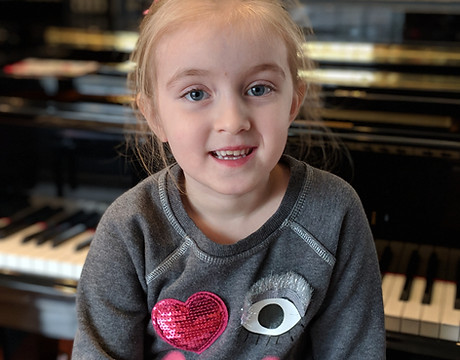
Suzuki Method
In 1945, a Japanese violinist named Shinichi Suzuki began a revolutionary teaching method that would eventually bear his name, but which he called “Talent Education.” His premise was that talent is not inborn, but can be developed to a high level in every person. Until his death in 1998 at the age of ninety-nine, Dr. Suzuki worked tirelessly to challenge the way we see our children and approach their learning. His method has been applied to many instruments as well as preschool. In order to develop a talent, Dr. Suzuki showed us that the following five conditions are necessary:

1. An Early Start
Children begin learning from before the time they are born. Many mothers report playing a piece of music regularly during pregnancy and afterward having the baby respond to that specific piece by becoming quiet and attentive.
In fact, children learn much more naturally and completely than adults, because they use all five senses when learning, rather than just their intellect. Children who begin music lessons as early as three, four, or five years of age can grow up with music-making being as natural as speaking or walking.

2. A Stimulating Environment
Despite all our efforts to consciously “teach” them, children are constantly learning on their own from their environment. A key, therefore, to help them develop an ability is to create the proper environment.
Children learn to speak and walk because everyone around them is doing these things. The tasks of learning language and music are similarly difficult and yet, although many people struggle with music, everyone speaks his own language fluently!
If children grow up hearing great recordings, seeing exciting performances, and making beautiful music together, they can become musically fluent as well.

3. A Natural Method
Beginning early and creating a good environment may fail if the child’s natural learning process is not respected. Children learn things in a step by step process, repeating each step until it is assimilated. This is why they speak their first words many times before using phrases, why phrases lead to sentences, and why reading begins after basic speaking fluency is attained.
Following this example, Suzuki Method begins music study through the ear, adding reading later on. Students first learn to play simple songs with good tone, rhythm, and body balance, and then move on to the separate study of reading.

4. A Concentrated Study
We should not ask children to do too many activities. It is good to expose them to a variety of things, but they should have the opportunity to have in–depth training in one or two disciplines. All educators—whether music, sports, academic, or dance—will testify to the fact that children need daily practice to develop ability.
In the process of achieving high ability in one area such as music, however, children acquire life skills—concentration, discipline, perseverance, and self-esteem—which will help them in all areas of life.

5. A Dedicated Instructor
Suzuki Method places great emphasis on the teacher being the best he or she can be. Because every child can be educated, the teacher accepts the responsibility to help all his or her students achieve their potential.
To accomplish this, teachers must reflect on their own teaching and continue to research both their own instrument (students play like their teacher!) and the learning process of children.
